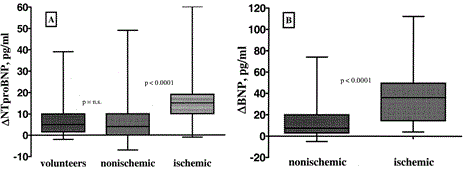Detection of exercise-induced ischemia by changes in B-type natriuretic peptides |
| |
| Authors: | Foote Robert S Pearlman Justin D Siegel Alan H Yeo Kiang-Teck J |
| |
| Affiliation: | Department of Medicine, Dartmouth Hitchcock Medical Center, Lebanon, New Hampshire 03756, USA. rsf@hitchcock.org |
| |
| Abstract: | 
OBJECTIVES: The purpose of this study was to examine the effect of exercise-induced ischemia on levels of B-type natriuretic peptide (BNP) and its inactive N-terminal fragment (NT-pro-BNP)and to determine whether measurement of these peptides can improve the diagnostic accuracy of exercise testing. BACKGROUND: The ability of exercise testing to detect coronary artery disease (CAD) is limited by modest sensitivity and specificity. B-type natriuretic peptides (NT-pro-BNP and BNP) are released by ventricular myocytes in response to wall stress. We hypothesized that exercise-induced ischemia results in increased wall stress and triggers release of NT-pro-BNP and BNP. METHODS: A total of 74 patients with known CAD, normal left ventricular function, and normal resting levels of NT-pro-BNP and BNP who were referred for exercise testing with radionuclide imaging, and 21 healthy volunteers, were enrolled. Blood was drawn before and after maximal exercise and analyzed for NT-pro-BNP and BNP. RESULTS: Of the patients with CAD, 40 had ischemia on perfusion images and 34 did not. Median post-exercise increases in NT-pro-BNP and BNP (DeltaNT-pro-BNP and DeltaBNP) were approximately four-fold higher in the ischemic group than in the nonischemic group (DeltaNT-pro-BNP 14.5 vs. 4 pg/ml, p < 0.0001; DeltaBNP 36.5 vs. 7.5 pg/ml, p < 0.0001). In volunteers, median DeltaNT-pro-BNP was almost identical to that of the nonischemic patient group. At equal specificity to the electrocardiogram (ECG) (58.8%), the sensitivities of DeltaNT-pro-BNP and DeltaBNP for detecting ischemia were 90% and 80%, respectively; in contrast, the sensitivity of the exercise ECG was 37.5%. CONCLUSIONS: Measurement of exercise-induced increases in BNPs more than doubles the sensitivity of the exercise test for detecting ischemia with no loss of specificity. |
| |
| Keywords: | |
| 本文献已被 ScienceDirect PubMed 等数据库收录! |
|

